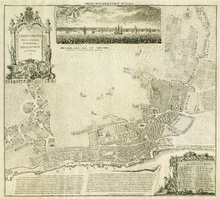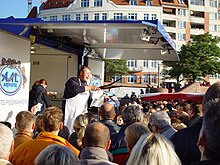Altona fish market
The Altonaer Fischmarkt is a public market in the Hamburg district of Altona-Altstadt . Its story is embedded in the competition between the two rival cities of Altona and Hamburg. It is now marketed as a tourist attraction, but it still has an economic function.
Plaza
Today's Altona fish market is delimited on the west and east by a multi-storey row of buildings with mixed use. These run at an angle in such a way that they constrict the area of the square approximately in the middle, so that it has the shape of two trapezoids that meet with the narrow side . The square is structurally open to the north and south. From the north through the east to the south, this square and building ensemble is surrounded by the following streets: Breite Straße , St. Pauli Fischmarkt and Große Elbstraße . The last-mentioned street and the open space behind it up to the quay wall is also used as an additional market area, while the higher-lying Breite Straße runs on a bridge over the level of the square into the winding St. Pauli Fischmarkt street , which today is only one row of buildings with its delimiting row of buildings Can fulfill the feeder function at the intersection with the Große Elbstraße.
history
Fishermen and craftsmen have settled at the gates of Hamburg since the 16th century. After Christian IV became Duke of Holstein in 1640, the Danes tried to compete with the Hanseatic city of Hamburg . 1664 awarded Friedrich III. Altona the town charter. Since 1703 it has been possible to trade in Altona on Sundays before going to church.
Originally the market held in Altona was used to supply the citizens with fresh fish. Fruit, vegetables and plants have also been sold on the Altona fish market since the early 18th century. The peculiarity of being open early on Sundays, too, is due to the fact that the fish landed with the fishing boats should be sold in the morning before going to church in order to get it as fresh as possible in the stately kitchens. On a map from 1770 "Grund-Riss der Stadt Altona", the fish market is marked with the letter "A" at the point where the "Elbstraße" and the "Kleine Elbstraße" meet.
As early as 1846, a track of the Altona port railway led from the Altona train station , initially with a cable elevator over the Geesthang and from 1876 through the haddock tunnel to the fish market. At times this was the place where the largest volume of sea fish and canned fish was handled by the canning industry based in the fish market area for the German inland areas. The tunnel is now closed, but can be visited with accompanying guides.
In 1896 the fish auction hall was opened in Altona, which was built in the style of a three-aisled basilica. Large fish steamers competed with the Elbe fishermen, and without the help of the auctioneer the wholesalers could have pushed through prices that were too low. As early as the 1930s, the auction hall was technically “obsolete”, and trade moved further west, where cold stores and fish processing plants were built. Today fish is auctioned in virtual auctions.
Fish market every Sunday
The traditional Sunday fish market takes place from 5:00 a.m. to 9:30 a.m. (from November 1st to March 31st from 7:00 a.m.) with outdoor stalls on the eastern end of the Große Elbstraße in Altona . The market has an economic and social function for local customers and dealers. The sometimes screeching behavior of the traders also makes the public fish market a tourist attraction. Around 70,000 visitors come on summer Sundays and between 5,000 and 10,000 on winter Sundays. The unusual market time on Sunday morning has historical reasons: In the 18th century Altona's fishermen complained that they were not allowed to sell fish on Sunday and that it often spoiled because of the lack of cooling facilities in summer. In the "Magistratus Ordinance because of the fishermen" of May 2, 1703, the city fathers of the then still small town of Altona allowed the fishermen to sell on Sunday mornings, but only until half past eight, so that they would come to the Sunday service in time. To date, the market time has only been extended by another hour.
Nowadays the offer is no longer limited to groceries. Technology accessories or tourist souvenirs are also offered; Live chickens, racing pigeons and rabbits are part of the traditional menu. After shopping, visitors can listen to jazz or rock music in the neighboring fish auction hall.
Waste disposal and cleaning
At the end of the market day, large amounts of waste remain on the site at the fish market. The Hamburg city cleaning service collects these unsorted professionally with garbage trucks and then cleans the area with sweepers. Typically, in addition to pure packaging waste, the waste also contains unsold food that is still edible. Delayed or needy visitors can take corresponding finds for their own consumption, provided that they do not hinder the cleaning process.
Development of the square
The area of the Sunday fish market was built on in different ways over the course of time. In July 1943, most of the residential and commercial buildings around the fish market, with a few exceptions, were completely destroyed by aerial bombs. In the 1970s, the city of Hamburg began to rebuild the square, which the Altonaer Spar- und Bauverein and the Bauverein der Elbgemeinden implemented from 1988 to 1992. Post-modern new buildings now form a unit with the "new buildings" from the Wilhelminian era. The baroque fish market fountain from 1742, which had stood here until 1864, was restored and put back on the square. The crowning Minerva statue was created by the Kiel sculptor Hans Kock in 1989 as a replacement for the damaged original figure. Next to the fish market is the stilwerk brick building , which was expanded in 1996 and served as a malt house from the 19th century onwards and currently offers a shop center for interior design and furniture design.
literature
- Hans-Günther Friday: Sundays until half past nine, 275 years of the Altona fish market. History and Döntjes , Altona 1978
- Magistrate of the city of Altona, Altona's fishing port and fish market 1896 , Altona 1896
- Hannes Bötticher, Cenci Goepel: Come here! Whole box one euro , DAS Fischmarktbuch, Altona 2006, Freistern-Verlag.
Web links
Individual evidence
- ↑ Data & facts about the fish market In: hamburg.de , accessed on November 2, 2019
- ↑ History of the fish market . Hamburg.de. Retrieved November 17, 2018.
- ↑ Hamburg Fish Market. In: hamburg-web.de , accessed on February 3, 2014
Coordinates: 53 ° 32 ′ 44.2 " N , 9 ° 57 ′ 15.4" E





